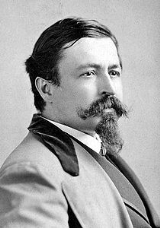
Thomas Nast
Encyclopedia
Thomas Nast was a German-born American caricaturist and editorial cartoonist
who is considered to be the "Father of the American Cartoon". He was the scourge of Boss Tweed
and the Tammany Hall
machine. Among his notable works were the creation of the modern version of Santa Claus
, and Uncle Sam
(the male personification of the American people), as well as the political symbols of both major United States political parties: the Republican
elephant and the Democratic
donkey.
, Germany
(now in Rhine Palatinate), the son of a trombonist in the 9th regiment Bavaria
n band and had a half sister named Andie. The elder Nast's socialist political convictions put him at odds with the Bavarian government, and in 1846 he left Landau, enlisting first on a French man-of-war and subsequently on an American ship. He sent his wife and children to New York City
, and at the end of his enlistment in 1849 he joined them there. Thomas Nast's passion for drawing was apparent from an early age, and he was enrolled for about a year of study with Alfred Fredericks and Theodore Kaufmann
and at the school of the National Academy of Design
. Nast attended school in New York City from the age of six to fifteen, when he was forced to drop out due to financial problems. Thomas had problems adjusting to life in America and never took well to school. He spent his entire school career on the verge of flunking out and consequently was not an especially good speller. After school he started working in 1855 as a draftsman for Frank Leslie's Illustrated Newspaper
; three years afterward, for Harper's Weekly
.
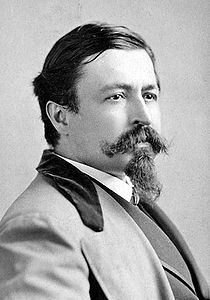
 Nast drew for Harper's Weekly from 1859 to 1860 and from 1862 until 1886. In February 1860, he went to England for the New York Illustrated News to depict one of the major sporting events of the era, the prize fight
Nast drew for Harper's Weekly from 1859 to 1860 and from 1862 until 1886. In February 1860, he went to England for the New York Illustrated News to depict one of the major sporting events of the era, the prize fight
between the American John C. Heenan
and the English Thomas Sayers
sponsored by George Wilkes
, publisher of Wilkes' Spirit of the Times
. A few months later, as artist for The Illustrated London News, he joined Garibaldi
in Italy. Nast's cartoons and articles about the Garibaldi military campaign to unify Italy
captured the popular imagination in the U.S. In 1861, he married Sarah Edwards, whom he had met two years earlier.
One of his first serious works in caricature was the cartoon "Peace" (1862), directed against those in the North who opposed the prosecution of the American Civil War
. This and his other cartoons during the Civil War and Reconstruction days were published in Harper's Weekly. He was known for drawing battlefields in border
and southern states
. These attracted great attention, and Nast was called by President Abraham Lincoln
"our best recruiting sergeant". Later, Nast strongly opposed President Andrew Johnson
and his Reconstruction policy.
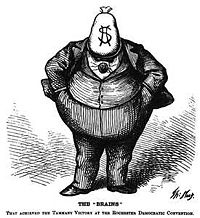
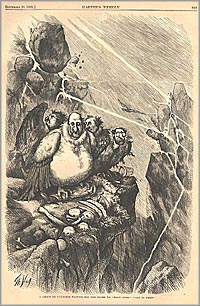 Nast's drawings were instrumental in the downfall of Boss Tweed
Nast's drawings were instrumental in the downfall of Boss Tweed
, the powerful Tammany Hall
leader. As commissioner of public works for New York City, Tweed led a ring that by 1870 had gained total control of the city's government, and controlled "a working majority in the State Legislature". Tweed and his associates—Peter Barr Sweeny
(park commissioner), Richard B. Connolly (controller of public expenditures), and Mayor A. Oakey Hall—defrauded the city of many millions of dollars by grossly inflating expenses paid to contractors connected to the Ring. Nast, whose cartoons attacking Tammany corruption had appeared occasionally since 1867, intensified his focus on the four principal players in 1870 and especially in 1871.
Tweed so feared Nast's campaign that an emissary was sent to offer Thomas Nast a large bribe, which was represented as a gift from a group of wealthy benefactors to enable Nast to study art in Europe. Feigning interest, Nast bid the initial offer of $100,000 up to $500,000 before declaring, "I don't think I'll do it." Nast pressed his attack, and an indignant public rose against the Ring, which was removed from power in the election of November 7, 1871. Tweed was arrested in 1873 and convicted of fraud. When Tweed attempted to escape justice in December 1875 by fleeing to Cuba and from there to Spain, officials in Vigo
, Spain
, were able to identify the fugitive by using one of Nast's cartoons.
Nast, a German Protestant, considered the Roman Catholic Church
a threat to American values, and often portrayed the Irish Catholics and Catholic Church leaders in hostile terms. In 1871, one of his works, titled "The American River Ganges," portrayed Catholic bishops as crocodiles waiting to attack American school children; they wanted to have Catholic schools for Catholic children. Nast expressed his feelings about ethnic Irish in his depictions of the Irish as violent drunks.

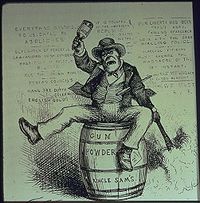
In general, his political cartoons supported American Indians and Chinese American
s. He advocated abolition of slavery
, opposed segregation
, and deplored the violence of the Ku Klux Klan
. One of his more famous cartoons, entitled "Worse than Slavery", showed a despondent black family having their house destroyed by arson
, as two members of the Ku Klux Klan
and White League
, paramilitary
insurgent
groups in the Reconstruction-era South, shake hands in their mutually destructive work against black Americans.
His cartoons frequently had numerous sidebars and panels with intricate subplots to the main cartoon. A Sunday feature could provide hours of entertainment and highlight social causes. His signature "Tammany Tiger" has been emulated by many cartoonists over the years. He introduced into American cartoons the practice of modernizing scenes from Shakespeare for a political purpose.

's candidacy was especially merciless. Nast became a close friend of President Grant and the two families shared regular dinners until Grant's death. Nast encouraged the former president's efforts in writing his autobiography while battling cancer.
He moved to Morristown, New Jersey
in 1872 and lived there for many years. In 1873, Nast toured the United States as a lecturer and a sketch-artist, as he would do again in 1885 and 1887.
He shared political views with his friend Mark Twain
and was for many years a staunch Republican. Nast opposed inflation
of the currency
, notably with his famous rag-baby cartoons, and he played an important part in securing Rutherford B. Hayes
’ presidential election in 1876. Hayes later remarked that Nast was "the most powerful, single-handed aid [he] had", but Nast quickly became disillusioned with President Hayes, whose policy of Southern pacification he opposed. He was not given free rein to attack Hayes in Harper's, however; with the death of Fletcher Harper
in 1877, Nast lost an important champion at the journal, and his contributions became less frequent. He focused on oil paintings and book illustrations, but these are comparatively unimportant.

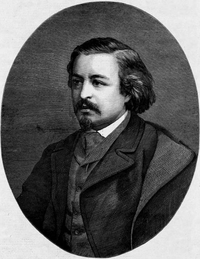 In 1884, his advocacy of civil service
In 1884, his advocacy of civil service
reform and his distrust of James G. Blaine
, the Republican presidential candidate, forced him to become a Mugwump
, whose support of Grover Cleveland
helped him to win election as the first Democratic president since 1856. In the words of the artist's grandson, Thomas Nast St Hill, "it was generally conceded that Nast's support won Cleveland the small margin by which he was elected. In this his last national political campaign, Nast had, in fact, 'made a president.'"
Nevertheless, Nast's tenure at Harper's Weekly ended with his Christmas illustration of December 1886. In the words of journalist Henry Watterson
, "in quitting Harper's Weekly, Nast lost his forum: in losing him, Harper's Weekly lost its political importance."
In 1892, he took control of a failing magazine, the New York Gazette, and renamed it Nast's Weekly. Now returned to the Republican fold, Nast used the Weekly as a vehicle for his cartoons supporting Benjamin Harrison
for president, but the magazine had little impact and ceased publication shortly after Harrison's defeat.
In 1902 Theodore Roosevelt
appointed him as the United States' Consul General to Guayaquil
, Ecuador
in South America
. During a deadly yellow fever
outbreak, Nast stayed to the end helping numerous diplomatic missions and businesses escape the contagion. He contracted the disease and died on December 7 of that year. His body was returned to the United States, where he was interred in the Woodlawn Cemetery in The Bronx
, New York
.
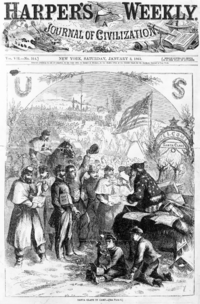 Nast's depiction of iconic characters, such as Santa Claus and Uncle Sam, are widely credited with giving us the recognized versions we see today.
Nast's depiction of iconic characters, such as Santa Claus and Uncle Sam, are widely credited with giving us the recognized versions we see today.
Editorial cartoonist
An editorial cartoonist, also known as a political cartoonist, is an artist who draws editorial cartoons that contain some level of political or social commentary....
who is considered to be the "Father of the American Cartoon". He was the scourge of Boss Tweed
Boss Tweed
William Magear Tweed – often erroneously referred to as William Marcy Tweed , and widely known as "Boss" Tweed – was an American politician most notable for being the "boss" of Tammany Hall, the Democratic Party political machine that played a major role in the politics of 19th century...
and the Tammany Hall
Tammany Hall
Tammany Hall, also known as the Society of St. Tammany, the Sons of St. Tammany, or the Columbian Order, was a New York political organization founded in 1786 and incorporated on May 12, 1789 as the Tammany Society...
machine. Among his notable works were the creation of the modern version of Santa Claus
Santa Claus
Santa Claus is a folklore figure in various cultures who distributes gifts to children, normally on Christmas Eve. Each name is a variation of Saint Nicholas, but refers to Santa Claus...
, and Uncle Sam
Uncle Sam
Uncle Sam is a common national personification of the American government originally used during the War of 1812. He is depicted as a stern elderly man with white hair and a goatee beard...
(the male personification of the American people), as well as the political symbols of both major United States political parties: the Republican
History of the United States Republican Party
The United States Republican Party is the second oldest currently existing political party in the United States after its great rival, the Democratic Party. It emerged in 1854 to combat the Kansas Nebraska Act which threatened to extend slavery into the territories, and to promote more vigorous...
elephant and the Democratic
History of the United States Democratic Party
The history of the Democratic Party of the United States is an account of the oldest political party in the United States and arguably the oldest democratic party in the world....
donkey.
Youth and education
He was born in the barracks of LandauLandau
Landau or Landau in der Pfalz is an autonomous city surrounded by the Südliche Weinstraße district of southern Rhineland-Palatinate, Germany. It is a university town , a long-standing cultural centre, and a market and shopping town, surrounded by vineyards and wine-growing villages of the...
, Germany
Germany
Germany , officially the Federal Republic of Germany , is a federal parliamentary republic in Europe. The country consists of 16 states while the capital and largest city is Berlin. Germany covers an area of 357,021 km2 and has a largely temperate seasonal climate...
(now in Rhine Palatinate), the son of a trombonist in the 9th regiment Bavaria
Bavaria
Bavaria, formally the Free State of Bavaria is a state of Germany, located in the southeast of Germany. With an area of , it is the largest state by area, forming almost 20% of the total land area of Germany...
n band and had a half sister named Andie. The elder Nast's socialist political convictions put him at odds with the Bavarian government, and in 1846 he left Landau, enlisting first on a French man-of-war and subsequently on an American ship. He sent his wife and children to New York City
New York City
New York is the most populous city in the United States and the center of the New York Metropolitan Area, one of the most populous metropolitan areas in the world. New York exerts a significant impact upon global commerce, finance, media, art, fashion, research, technology, education, and...
, and at the end of his enlistment in 1849 he joined them there. Thomas Nast's passion for drawing was apparent from an early age, and he was enrolled for about a year of study with Alfred Fredericks and Theodore Kaufmann
Theodore Kaufmann
Theodore Kaufmann was an artist who worked mostly in the United States.-Biography:He served for several years as a mercantile apprentice. He studied painting in Düsseldorf with Peter von Cornelius, in Munich with Wilhelm von Kaulbach, and also in Hamburg and Dresden...
and at the school of the National Academy of Design
National Academy of Design
The National Academy Museum and School of Fine Arts, founded in New York City as the National Academy of Design – known simply as the "National Academy" – is an honorary association of American artists founded in 1825 by Samuel F. B. Morse, Asher B. Durand, Thomas Cole, Martin E...
. Nast attended school in New York City from the age of six to fifteen, when he was forced to drop out due to financial problems. Thomas had problems adjusting to life in America and never took well to school. He spent his entire school career on the verge of flunking out and consequently was not an especially good speller. After school he started working in 1855 as a draftsman for Frank Leslie's Illustrated Newspaper
Frank Leslie's Weekly
Frank Leslie's Weekly, later often known in short as Leslie's Weekly, was an American illustrated literary and news magazine founded in 1852 and continuing publication well into the 20th century. As implied by its name, it was published weekly, on Tuesdays. Its first editor was John Y. Foster...
; three years afterward, for Harper's Weekly
Harper's Weekly
Harper's Weekly was an American political magazine based in New York City. Published by Harper & Brothers from 1857 until 1916, it featured foreign and domestic news, fiction, essays on many subjects, and humor...
.
Career


Boxing
Boxing, also called pugilism, is a combat sport in which two people fight each other using their fists. Boxing is supervised by a referee over a series of between one to three minute intervals called rounds...
between the American John C. Heenan
John C. Heenan
John Camel Heenan, aka the Benicia Boy was an American bare-knuckle prize fighter. Though highly regarded, he had only three formal fights in his entire career, losing two and drawing one....
and the English Thomas Sayers
Thomas Sayers
Tom Sayers was an English bare-knuckle prize fighter. There were no formal weight divisions at the time, and although Sayers was only five feet eight inches tall and never weighed much more than 150 pounds, he frequently fought much bigger men...
sponsored by George Wilkes
George Wilkes
-Early life:Wilkes was born in 1817 in New York state in the United States. His parents may have been George Wilkes, a cabinet maker, and Helen, although this is not certain. The younger Wilkes became a law clerk for Enoch E. Camp, but left the legal profession for journalism...
, publisher of Wilkes' Spirit of the Times
Spirit of the Times
The Spirit of the Times: A Chronicle of the Turf, Agriculture, Field Sports, Literature and the Stage was an American weekly newspaper published in New York City. The paper aimed for an upper-class readership made up largely of sportsmen. The Spirit also included humorous material, much of it based...
. A few months later, as artist for The Illustrated London News, he joined Garibaldi
Giuseppe Garibaldi
Giuseppe Garibaldi was an Italian military and political figure. In his twenties, he joined the Carbonari Italian patriot revolutionaries, and fled Italy after a failed insurrection. Garibaldi took part in the War of the Farrapos and the Uruguayan Civil War leading the Italian Legion, and...
in Italy. Nast's cartoons and articles about the Garibaldi military campaign to unify Italy
Italian unification
Italian unification was the political and social movement that agglomerated different states of the Italian peninsula into the single state of Italy in the 19th century...
captured the popular imagination in the U.S. In 1861, he married Sarah Edwards, whom he had met two years earlier.
One of his first serious works in caricature was the cartoon "Peace" (1862), directed against those in the North who opposed the prosecution of the American Civil War
American Civil War
The American Civil War was a civil war fought in the United States of America. In response to the election of Abraham Lincoln as President of the United States, 11 southern slave states declared their secession from the United States and formed the Confederate States of America ; the other 25...
. This and his other cartoons during the Civil War and Reconstruction days were published in Harper's Weekly. He was known for drawing battlefields in border
Border states (Civil War)
In the context of the American Civil War, the border states were slave states that did not declare their secession from the United States before April 1861...
and southern states
Confederate States of America
The Confederate States of America was a government set up from 1861 to 1865 by 11 Southern slave states of the United States of America that had declared their secession from the U.S...
. These attracted great attention, and Nast was called by President Abraham Lincoln
Abraham Lincoln
Abraham Lincoln was the 16th President of the United States, serving from March 1861 until his assassination in April 1865. He successfully led his country through a great constitutional, military and moral crisis – the American Civil War – preserving the Union, while ending slavery, and...
"our best recruiting sergeant". Later, Nast strongly opposed President Andrew Johnson
Andrew Johnson
Andrew Johnson was the 17th President of the United States . As Vice-President of the United States in 1865, he succeeded Abraham Lincoln following the latter's assassination. Johnson then presided over the initial and contentious Reconstruction era of the United States following the American...
and his Reconstruction policy.
Campaign against the Tweed Ring


Boss Tweed
William Magear Tweed – often erroneously referred to as William Marcy Tweed , and widely known as "Boss" Tweed – was an American politician most notable for being the "boss" of Tammany Hall, the Democratic Party political machine that played a major role in the politics of 19th century...
, the powerful Tammany Hall
Tammany Hall
Tammany Hall, also known as the Society of St. Tammany, the Sons of St. Tammany, or the Columbian Order, was a New York political organization founded in 1786 and incorporated on May 12, 1789 as the Tammany Society...
leader. As commissioner of public works for New York City, Tweed led a ring that by 1870 had gained total control of the city's government, and controlled "a working majority in the State Legislature". Tweed and his associates—Peter Barr Sweeny
Peter B. Sweeny
Peter Barr Sweeny was an American lawyer and politician from New York.-Life:He was the son of James Sweeny, who kept a hotel in Hoboken, New Jersey, and Mary Sweeny....
(park commissioner), Richard B. Connolly (controller of public expenditures), and Mayor A. Oakey Hall—defrauded the city of many millions of dollars by grossly inflating expenses paid to contractors connected to the Ring. Nast, whose cartoons attacking Tammany corruption had appeared occasionally since 1867, intensified his focus on the four principal players in 1870 and especially in 1871.
Tweed so feared Nast's campaign that an emissary was sent to offer Thomas Nast a large bribe, which was represented as a gift from a group of wealthy benefactors to enable Nast to study art in Europe. Feigning interest, Nast bid the initial offer of $100,000 up to $500,000 before declaring, "I don't think I'll do it." Nast pressed his attack, and an indignant public rose against the Ring, which was removed from power in the election of November 7, 1871. Tweed was arrested in 1873 and convicted of fraud. When Tweed attempted to escape justice in December 1875 by fleeing to Cuba and from there to Spain, officials in Vigo
Vigo
Vigo is a city and municipality in north-west Spain, in Galicia, situated on the ria of the same name on the Atlantic Ocean.-Population:...
, Spain
Spain
Spain , officially the Kingdom of Spain languages]] under the European Charter for Regional or Minority Languages. In each of these, Spain's official name is as follows:;;;;;;), is a country and member state of the European Union located in southwestern Europe on the Iberian Peninsula...
, were able to identify the fugitive by using one of Nast's cartoons.
Nast, a German Protestant, considered the Roman Catholic Church
Roman Catholic Church
The Catholic Church, also known as the Roman Catholic Church, is the world's largest Christian church, with over a billion members. Led by the Pope, it defines its mission as spreading the gospel of Jesus Christ, administering the sacraments and exercising charity...
a threat to American values, and often portrayed the Irish Catholics and Catholic Church leaders in hostile terms. In 1871, one of his works, titled "The American River Ganges," portrayed Catholic bishops as crocodiles waiting to attack American school children; they wanted to have Catholic schools for Catholic children. Nast expressed his feelings about ethnic Irish in his depictions of the Irish as violent drunks.


In general, his political cartoons supported American Indians and Chinese American
Chinese American
Chinese Americans represent Americans of Chinese descent. Chinese Americans constitute one group of overseas Chinese and also a subgroup of East Asian Americans, which is further a subgroup of Asian Americans...
s. He advocated abolition of slavery
Abolitionism
Abolitionism is a movement to end slavery.In western Europe and the Americas abolitionism was a movement to end the slave trade and set slaves free. At the behest of Dominican priest Bartolomé de las Casas who was shocked at the treatment of natives in the New World, Spain enacted the first...
, opposed segregation
Racial segregation
Racial segregation is the separation of humans into racial groups in daily life. It may apply to activities such as eating in a restaurant, drinking from a water fountain, using a public toilet, attending school, going to the movies, or in the rental or purchase of a home...
, and deplored the violence of the Ku Klux Klan
Ku Klux Klan
Ku Klux Klan, often abbreviated KKK and informally known as the Klan, is the name of three distinct past and present far-right organizations in the United States, which have advocated extremist reactionary currents such as white supremacy, white nationalism, and anti-immigration, historically...
. One of his more famous cartoons, entitled "Worse than Slavery", showed a despondent black family having their house destroyed by arson
Arson
Arson is the crime of intentionally or maliciously setting fire to structures or wildland areas. It may be distinguished from other causes such as spontaneous combustion and natural wildfires...
, as two members of the Ku Klux Klan
Ku Klux Klan
Ku Klux Klan, often abbreviated KKK and informally known as the Klan, is the name of three distinct past and present far-right organizations in the United States, which have advocated extremist reactionary currents such as white supremacy, white nationalism, and anti-immigration, historically...
and White League
White League
The White League was a white paramilitary group started in 1874 that operated to turn Republicans out of office and intimidate freedmen from voting and political organizing. Its first chapter in Grant Parish, Louisiana was made up of many of the Confederate veterans who had participated in the...
, paramilitary
Paramilitary
A paramilitary is a force whose function and organization are similar to those of a professional military, but which is not considered part of a state's formal armed forces....
insurgent
Insurgent
Insurgent, insurgents or insurgency can refer to:* The act of insurgency-Specific insurgencies:* Iraqi insurgency, uprising in Iraq* Insurgency in Jammu and Kashmir, uprising in India* Insurgency in North-East India...
groups in the Reconstruction-era South, shake hands in their mutually destructive work against black Americans.
His cartoons frequently had numerous sidebars and panels with intricate subplots to the main cartoon. A Sunday feature could provide hours of entertainment and highlight social causes. His signature "Tammany Tiger" has been emulated by many cartoonists over the years. He introduced into American cartoons the practice of modernizing scenes from Shakespeare for a political purpose.

Party politics
Harper's Weekly, and Nast, played an important role in the election of Ulysses Grant in 1868 and 1872; in the latter campaign, Nast's ridicule of Horace GreeleyHorace Greeley
Horace Greeley was an American newspaper editor, a founder of the Liberal Republican Party, a reformer, a politician, and an outspoken opponent of slavery...
's candidacy was especially merciless. Nast became a close friend of President Grant and the two families shared regular dinners until Grant's death. Nast encouraged the former president's efforts in writing his autobiography while battling cancer.
He moved to Morristown, New Jersey
Morristown, New Jersey
Morristown is a town in Morris County, New Jersey, United States. As of the 2010 United States Census, the town population was 18,411. It is the county seat of Morris County. Morristown became characterized as "the military capital of the American Revolution" because of its strategic role in the...
in 1872 and lived there for many years. In 1873, Nast toured the United States as a lecturer and a sketch-artist, as he would do again in 1885 and 1887.
He shared political views with his friend Mark Twain
Mark Twain
Samuel Langhorne Clemens , better known by his pen name Mark Twain, was an American author and humorist...
and was for many years a staunch Republican. Nast opposed inflation
Inflation
In economics, inflation is a rise in the general level of prices of goods and services in an economy over a period of time.When the general price level rises, each unit of currency buys fewer goods and services. Consequently, inflation also reflects an erosion in the purchasing power of money – a...
of the currency
Currency
In economics, currency refers to a generally accepted medium of exchange. These are usually the coins and banknotes of a particular government, which comprise the physical aspects of a nation's money supply...
, notably with his famous rag-baby cartoons, and he played an important part in securing Rutherford B. Hayes
Rutherford B. Hayes
Rutherford Birchard Hayes was the 19th President of the United States . As president, he oversaw the end of Reconstruction and the United States' entry into the Second Industrial Revolution...
’ presidential election in 1876. Hayes later remarked that Nast was "the most powerful, single-handed aid [he] had", but Nast quickly became disillusioned with President Hayes, whose policy of Southern pacification he opposed. He was not given free rein to attack Hayes in Harper's, however; with the death of Fletcher Harper
Fletcher Harper
Fletcher Harper was an American publisher in the early-to-mid 19th century. Fletcher was the youngest of four sons born to Joseph Henry Harper, , a farmer, carpenter, and storekeeper, and Elizabeth Kollyer, a Dutch burgher's daughter...
in 1877, Nast lost an important champion at the journal, and his contributions became less frequent. He focused on oil paintings and book illustrations, but these are comparatively unimportant.


Civil service
The term civil service has two distinct meanings:* A branch of governmental service in which individuals are employed on the basis of professional merit as proven by competitive examinations....
reform and his distrust of James G. Blaine
James G. Blaine
James Gillespie Blaine was a U.S. Representative, Speaker of the United States House of Representatives, U.S. Senator from Maine, two-time Secretary of State...
, the Republican presidential candidate, forced him to become a Mugwump
Mugwump
The Mugwumps were Republican political activists who bolted from the United States Republican Party by supporting Democratic candidate Grover Cleveland in the United States presidential election of 1884. They switched parties because they rejected the financial corruption associated with Republican...
, whose support of Grover Cleveland
Grover Cleveland
Stephen Grover Cleveland was the 22nd and 24th president of the United States. Cleveland is the only president to serve two non-consecutive terms and therefore is the only individual to be counted twice in the numbering of the presidents...
helped him to win election as the first Democratic president since 1856. In the words of the artist's grandson, Thomas Nast St Hill, "it was generally conceded that Nast's support won Cleveland the small margin by which he was elected. In this his last national political campaign, Nast had, in fact, 'made a president.'"
Nevertheless, Nast's tenure at Harper's Weekly ended with his Christmas illustration of December 1886. In the words of journalist Henry Watterson
Henry Watterson
Henry Watterson was a United States journalist who founded the Louisville Courier-Journal.He also served part of one term in the United States House of Representatives as a Democrat....
, "in quitting Harper's Weekly, Nast lost his forum: in losing him, Harper's Weekly lost its political importance."
After Harper's Weekly
In 1890, Nast published Thomas Nast's Christmas Drawings for the Human Race. He contributed cartoons in various publications, notably the Illustrated American, but was unable to regain his earlier popularity.In 1892, he took control of a failing magazine, the New York Gazette, and renamed it Nast's Weekly. Now returned to the Republican fold, Nast used the Weekly as a vehicle for his cartoons supporting Benjamin Harrison
Benjamin Harrison
Benjamin Harrison was the 23rd President of the United States . Harrison, a grandson of President William Henry Harrison, was born in North Bend, Ohio, and moved to Indianapolis, Indiana at age 21, eventually becoming a prominent politician there...
for president, but the magazine had little impact and ceased publication shortly after Harrison's defeat.
In 1902 Theodore Roosevelt
Theodore Roosevelt
Theodore "Teddy" Roosevelt was the 26th President of the United States . He is noted for his exuberant personality, range of interests and achievements, and his leadership of the Progressive Movement, as well as his "cowboy" persona and robust masculinity...
appointed him as the United States' Consul General to Guayaquil
Guayaquil
Guayaquil , officially Santiago de Guayaquil , is the largest and the most populous city in Ecuador,with about 2.3 million inhabitants in the city and nearly 3.1 million in the metropolitan area, as well as that nation's main port...
, Ecuador
Ecuador
Ecuador , officially the Republic of Ecuador is a representative democratic republic in South America, bordered by Colombia on the north, Peru on the east and south, and by the Pacific Ocean to the west. It is one of only two countries in South America, along with Chile, that do not have a border...
in South America
South America
South America is a continent situated in the Western Hemisphere, mostly in the Southern Hemisphere, with a relatively small portion in the Northern Hemisphere. The continent is also considered a subcontinent of the Americas. It is bordered on the west by the Pacific Ocean and on the north and east...
. During a deadly yellow fever
Yellow fever
Yellow fever is an acute viral hemorrhagic disease. The virus is a 40 to 50 nm enveloped RNA virus with positive sense of the Flaviviridae family....
outbreak, Nast stayed to the end helping numerous diplomatic missions and businesses escape the contagion. He contracted the disease and died on December 7 of that year. His body was returned to the United States, where he was interred in the Woodlawn Cemetery in The Bronx
The Bronx
The Bronx is the northernmost of the five boroughs of New York City. It is also known as Bronx County, the last of the 62 counties of New York State to be incorporated...
, New York
New York
New York is a state in the Northeastern region of the United States. It is the nation's third most populous state. New York is bordered by New Jersey and Pennsylvania to the south, and by Connecticut, Massachusetts and Vermont to the east...
.
Notable works

- A classic version of Santa ClausSanta ClausSanta Claus is a folklore figure in various cultures who distributes gifts to children, normally on Christmas Eve. Each name is a variation of Saint Nicholas, but refers to Santa Claus...
, drawn in 1863 for Harper's Weekly. Before then, most depictions of Santa Claus showed a tall, thin man. Nast drew him as the bearded, plump man known today. - Republican PartyRepublican Party (United States)The Republican Party is one of the two major contemporary political parties in the United States, along with the Democratic Party. Founded by anti-slavery expansion activists in 1854, it is often called the GOP . The party's platform generally reflects American conservatism in the U.S...
elephant - Democratic PartyDemocratic Party (United States)The Democratic Party is one of two major contemporary political parties in the United States, along with the Republican Party. The party's socially liberal and progressive platform is largely considered center-left in the U.S. political spectrum. The party has the lengthiest record of continuous...
donkey - Tammany HallTammany HallTammany Hall, also known as the Society of St. Tammany, the Sons of St. Tammany, or the Columbian Order, was a New York political organization founded in 1786 and incorporated on May 12, 1789 as the Tammany Society...
tiger, a symbol of Boss TweedBoss TweedWilliam Magear Tweed – often erroneously referred to as William Marcy Tweed , and widely known as "Boss" Tweed – was an American politician most notable for being the "boss" of Tammany Hall, the Democratic Party political machine that played a major role in the politics of 19th century...
's political machinePolitical machineA political machine is a political organization in which an authoritative boss or small group commands the support of a corps of supporters and businesses , who receive rewards for their efforts... - ColumbiaHistorical ColumbiaColumbia is an historical and poetic name for America – and the early United States of America in particular, for which it is also the name of its female personification...
, a graceful image of the Americas as a woman, usually in flowing gown and tiara, carrying a sword to defend the downtrodden. - Uncle SamUncle SamUncle Sam is a common national personification of the American government originally used during the War of 1812. He is depicted as a stern elderly man with white hair and a goatee beard...
, a lanky image of the United States (first drawn in the 1830s; Nast and John TennielJohn TennielSir John Tenniel was a British illustrator, graphic humorist and political cartoonist whose work was prominent during the second half of England’s 19th century. Tenniel is considered important to the study of that period’s social, literary, and art histories...
added the goateeGoateeGoatee refers to a style of facial hair incorporating hair on a man’s chin. The exact nature of the style has varied according to time and culture.Traditionally, goatee refers solely to a beard formed by a tuft of hair on the chin...
). - John Confucius, a variation of John ChinamanJohn ChinamanJohn Chinaman was a stock caricature of a Chinese laborer seen in cartoons of the 19th century. Also referenced by Mark Twain and popular American songs of the period, John Chinaman represented, in western society, a typical persona of China...
, a traditional caricature of a Chinese Immigrant. - The Fight at Dame Europa's School, 1871
Myth of the word "nasty"
A popular myth says that the word "nasty" was based on Thomas Nast's name, due to the tone of his cartoons. But, the word "nasty" has origins in Old French and Dutch hundreds of years before Nast was born.External links
- Elections 1860-1912 as covered by Harper's Weekly; news, editorials, cartoons (many by Nast)
- still more Nast
- ThomasNast.com
- Thomas Nast Civil War Pictures
- Thomas Nast Caricatures of the Civil War, Reconstruction, Santa Claus, Napoleon, Catholicism, Boss Tweed, Tammany Hall and more.
- Cartoons of Thomas Nast: Reconstruction, Chinese Immigration, Native Americans, Gilded Era
- The Thomas Nast Collection--Morristown & Morris Township Public Library, NJ
- http://www.historybuff.com/library/refnast.html

